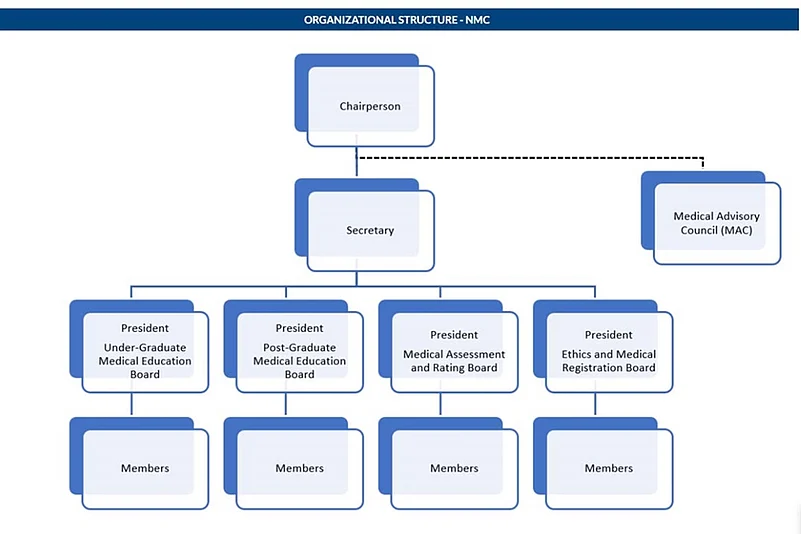The new medical education regulator, National Medical Commission (NMC)’s website has placed the chairman at the top of the organisational hierarchy, suggesting that he is the whole and sole authority of the commission. However, granting such authority to the chairman violates the NMC Act.
National Medical Commission: Website ‘Flouts’ Law, Messes Up Organisational Structure
The NMC Act says that it is a 32-member body and all decisions will be made by voting of the majority of its members.

The Act gives power to the chairman for general superintendence, direction and control of the administration of the NMC. It says that NMC is a 32-member body and all decisions will be made by voting of the majority of its members.
According to the website, the secretary comes second in the hierarchical order. It has placed four autonomous boards under the secretary which contradicts the Act as the secretary has to assist the boards in secretarial functions and not supersede them.

The organogram raises questions on the Union government’s argument of creating a more democratic regulator than the erstwhile Medical Council of India (MCI).
What Does The NMC Act Say?
The government passed a law on August 8, 2019, and replaced the MCI with NMC. The NMC Act says that the commission will consist of 32 members which include a chairman, 10 ex-officio members and 21 part-time members.
The Union government officially constituted the NMC by appointing a chairman, a secretary and 29 members on September 24, 2020, which effectively abolished the MCI. One post has remained vacant.
The power and function of the commission are to maintain a high standard of medical education and regulate medical institutions among others.
The Act says that the government will constitute four autonomous boards under the overall supervision of the commission. These are (a) the Under-Graduate Medical Education Board; (b) the Post-Graduate Medical Education Board; (c) the Medical Assessment and Rating Board; and (d) the Ethics and Medical Registration Board.
The organisational structure on the website puts these four boards directly under the secretary of NMC. He is shown to be reporting to the chairman.
“The secretary comes second in the hierarchical order and the so-called four autonomous boards seem to be reporting to the secretary and chairman,” a senior member of the erstwhile MCI said requesting anonymity.
He added, “The NMC has been granted appellate powers and any person aggrieved by the decision of four boards can make an appeal to the NMC. So, if such an arrangement continues as shown on the website, it is an end to the autonomy of four boards, which is the USP of the NMC Act. It also ends the appellate powers of NMC.”
The Proposed Organisational Structure
The 92nd report of the Parliamentary Standing Committee constituted to review the NMC draft bill, referred to NMC’s organogram as suggested by the Ranjit Roy Chaudhary Committee.
The Chaudhary committee had suggested an organogram placing NMC on the top and four boards under it. The Medical Advisory Council (MAC) was shown as a separate body parallel to the NMC.

However, the new website brings MAC under the authority of the chairman.
The MAC is a platform through which “the States and Union territories may put forth their views and concerns before the commission and help in shaping the overall agenda, policy and action relating to medical education and training.”
Experts say that chairman is first among equal to all the remaining 31 members. “Even if the chairman is placed on the top for administrative purposes, the four boards should have been shown directly under the chairman and not under the secretary,” an expert, involved in the consultative process at the drafting stage of the NMC bill, said.
Outlook wrote an e-mail to both the chairman and the secretary and pointed out the error in the organogram but they didn’t respond.
- Previous Story
 Elections 2024: Ashok Tanwar Joins Congress Again; Sehwag Endorses Congress Candidate In Haryana
Elections 2024: Ashok Tanwar Joins Congress Again; Sehwag Endorses Congress Candidate In Haryana - Next Story
























